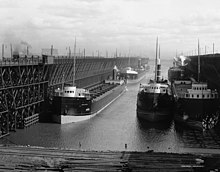Duluth, Missabe and Iron Range Railway
| File:Logo of the Duluth, Missabe and Iron Range Railway.jpg | |
 Map of the DMIR railroad. Solid lines are track still in use; dotted lines are abandoned track. | |
| Overview | |
|---|---|
| Headquarters | Proctor, Minnesota |
| Reporting mark | DMIR |
| Locale | northern Minnesota and Wisconsin |
| Dates of operation | 1874–2004 |
| Successor | Canadian National |
The Duluth, Missabe and Iron Range Railway (DM&IR) (reporting mark DMIR) was a railroad operating in northern Minnesota and Wisconsin to haul iron ore and later taconite to the Great Lakes port of Duluth, Minnesota and Two Harbors, Minnesota. The railway was acquired on May 10, 2004, by Canadian National Railway (CN) when it purchased the assets of Great Lakes Transportation.
History
The DM&IR was formed by the 1938 merger of the Duluth and Iron Range Railway (D&IR) and Duluth, Missabe and Northern Railway (DM&N).
The D&IR was formed in 1881 by Charlemagne Tower to haul iron ore from the Minnesota Iron Co. in Tower, Minnesota to the new Lake Superior port of Two Harbors, Minnesota. The first ore shipment from the Soudan Mine over the D&IR was on July 31, 1884. The D&IR was acquired by Illinois Steel in 1887. In 1901, Illinois Steel became part of the newly formed United States Steel Corporation (USS) and the railway became part of its holdings.
The DM&N was incorporated in 1891 and the first load of iron ore was shipped to Superior, Wisconsin in October, 1892. (The formation of the railway was necessary after the discovery of high-grade Mesabi iron ore near Mountain Iron, Minnesota by the Merritt brothers. The D&IR was approached to construct a new branch line, but was not receptive.) The Merritt's expanded DM&N by laying track to Duluth, Minnesota in 1893 and built an ore dock there. The Merritt's shaky financial position, brought in part to building the Duluth expansion, allowed for John D. Rockefeller to gain control of the railway in 1894. In 1901, Rockefeller sold the DM&N to USS.
From 1901 to 1938 the two railways were owned and operated by USS and were operated independently.

Merger

By July of 1938 the two railways merged to form the DM&IR. The railway had two operating divisions, the Missabe and the Iron Range based upon their predecessor's roads. As the United States began to prepare for the Second World War, the iron ore tonnage moving over the Missabe Road more than doubled from little over 8 million tons in 1938 to over 18 million tons in 1939 and lept to almost 28 million tons in 1940 and over 37 million tons in 1941.
With such high tonnage levels, it was obvious that DM&IR needed additional locomotive power to handle the higher traffic volume. The first eight of DM&IR's famous 2-8-8-4 Yellowstone locomotives were delivered by Baldwin Locomotive Works in the Spring of 1941. Total ore movement of nearly 45 million tons in 1942 stressed the critical need for more locomotive power on the DM&IR and the War Production Board allowed the Missabe to order ten more Yellowstones. The new locomotives were delivered in 1943.
Dieselization
After WWII, the DM&IR continued to haul increasing larger tonnage of ore to the ore docks along Lake Superior reaching an all-time record year of over 49 million tons in 1953. Also in 1953, the first diesel locomotives, EMD SW9s, arrived on the railway. The Missabe continues to dieselize with the 1956 delivery of EMD SD9s. The last revenue steam run occurred in 1960. Passenger services on the Missabe division ended in 1957 and completely ceased in 1961.
In addition to dieselization and the end of passenger service, other changes were happening to the DM&IR. The availability of high-quality iron ore was becoming limited. Mines and pits were closing across Minnesota's iron ranges. The DM&IR's ore docks in Two Harbors were closed in 1963 and didn't reopen until 1966. The Missabe Road was saved by the November 3, 1963 passage of the Taconite Amendment to the Minnesota State Constitution. (The amendment restricted the state's ability to tax a taconite industry for twenty-five years.) The passage of the amendment accelerated the creation of taconite mining industry in Northern Minnesota. The Eveleth Taconite Company was formed in 1964 and on April 8, 1966, the SS Edmund Fitzgerald took on the first load of Eveleth taconite pellets, totally about 23,000 tons. The taconite era on the Missabe had begun.
In 1988, U.S. Steel, now USX, spun off the DM&IR and their other ore railroads and shipping companies into subsidiary Transtar, then sold majority control to the Blackstone Group and USX. In 2001, the DM&IR, and other holdings, were spun off from Transtar into the company Great Lakes Transportation (GLT) which was owned fully by the Blackstone Group. (For the first time in over 100 years DM&IR was no longer associated with U.S. Steel.) In late 2003, the Blackstone Group agreed to sell GLT to Canadian National Railway and the purchase was finalized on May 10, 2004.
External links
- Missabe Railroad Historical Society
- CN acquires DM&IR
- DMI&R History [1]
Sources
- Frank A. King, The Missabe Road, (ISBN 0-8166-4083-1)
